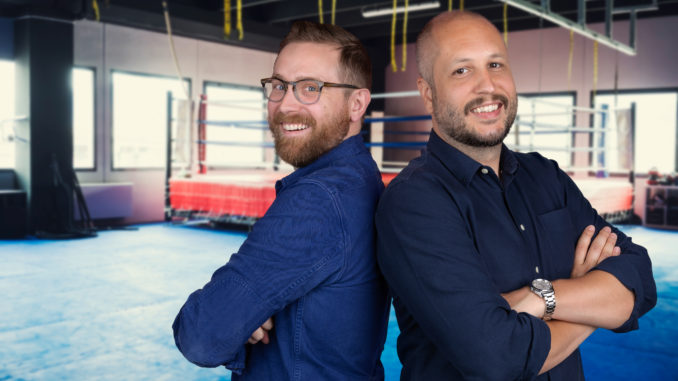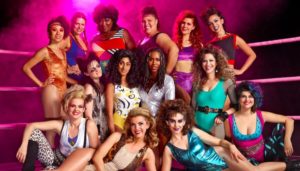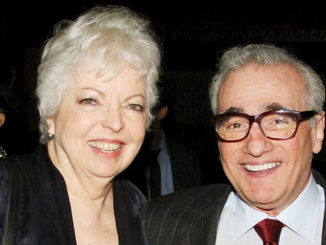
by Rob Feld
On GLOW (Gorgeous Ladies of Wrestling), the body slams and pile drivers come from the women in the ring. But the well-placed cuts arrive courtesy of editors Tyler L. Cook and Anthony Rosc.
With Season 3 scheduled to start streaming August 9, the Netflix comedy tells the fictionalized story of a group of down-on-their-luck women who respond to a casting call to launch a pro wrestling show, a la World Wrestling Federation. They create colorful characters for themselves and battle to make the show a hit, while trying to overcome their own personal struggles.
Cook and Rosc have been on the show since its inception, with Rosc bumped up to editor from assistant editor on Season 2.
Cook taught himself Final Cut Pro in high school, inspired to make movies after seeing Toy Story. He went to film school at North Carolina School of the Arts and used its network to spend summers in the editing departments of alumni’s indie films.
Rosc studied film at Columbia College in Chicago, where he fell in love with editing. He had started school as a writer/director, but “the power that you have in the editing room to put something together was intoxicating,” he says.
Rosc went on to American Film Institute’s conservatory as an editing fellow and got a job as a post PA on a feature with Niven Howie, ACE, with whom he worked for many years, eventually making his way up to first assistant editor.
When Howie went to the UK for a job, Rosc moved to assist Cook on GLOW.
CineMontage: GLOW is a comedy, but there’s a great deal of pathos in it as well. What does that mean for the edit?
Tyler Cook: The writers want it to feel like real life. We have dramatic moments mixed with comedy, comedy mixed with drama. So, for me, it’s honoring that and staying true to that, and understanding the way those things can play off each other, enhance one another, and subvert one another. It’s a good equalizer and keeps the show from feeling false.
Anthony Rosc: Our characters are going through so much in their lives, to try to progress themselves as people and as women in a patriarchal society, and they are in an industry where they’re still trying to get their voices heard. We always try to play the comedy first, but underneath everything and around that comedy are great, poignant, dramatic moments, and as an editor, it’s wonderful to be able to play with both of those elements.
CM: How would you describe the visual style?
TC: When we started this series, there were a lot of conversations and references put forward. Boogie Nights was a huge reference for [creators] Liz [Flahive] and Carly [Mensch] in terms of its cinematic realism. The way that they designed shots and the fluid way they move the camera never betray the reality of the movie and its time period. Also, because this is a period piece set in the ’80s, I think they were using it as an example of doing period without winking at the audience — letting things exist and be, as opposed to forcing an aesthetic on it.
AR: The showrunners always want character to shine, so they don’t want to over-cut things. When you’ve got such great scripts and performance across the board, we can let the characters tell the story. We don’t need to facilitate it with cutting around or cutting their performance, or cutting to help a joke, because they’re all working on such a high level. We can just live in a two-shot or a wider shot and just let it play, and it’s going to work. We’ve got 12, 14 characters that you’re trying to service and a lot of times, we’ve got most of them in one scene. And they’re all doing something interesting in the background. So, letting things play a little wider is often times the best way to tell that story.
TC: We’re mostly shooting two cameras, but when it gets into more of the ensemble scenes and the ring, it’s not uncommon to shoot three. We do have a lot of conversations before we shoot. We have a tone meeting when the director, showrunners, and editor can talk about what each scene needs to be from a story point of view — what is the scene trying to say and whose scene is it. That helps make a lot of my decisions in the editing room, like what coverage brings you into a scene and who brings an end to the scene.
CM: With the Netflix model, you have some ability to go back and adjust some episodes within the full context of the edited season before it goes live. What’s that like?
TC: It’s a real benefit. You get to look at the season holistically and determine ways of improving moments to play later. We don’t really lock anything until well after shooting is wrapped. So, there may be certain storylines didn’t quite pan out the way that we wanted them to. Because it’s such a large ensemble, we try to write storylines for everybody, but then our episodes end up being way too long. So what we decide to prioritize, or let go of, has a ripple effect. Or, if we had to cut a character out of an episode, we may want to give them their due in a later episode, or what have you. There is a lot of balancing in that way that we’re able to calibrate as we go through the season. It’s a wonderful process for having some time away from an episode, too, before circling back to it and re-evaluating. It feels creatively rewarding and helps make sure the end product feels as polished as it can be.

AR: On a show like this, which has so much heart and such a big ensemble, you’re really working all those editor muscles. I just feel really lucky to be able to work on something that’s so challenging and rewarding.
CineMontage: How do you handle notes?
TC: In the case of GLOW, the show runners are on set and you’re left cutting by yourself. You’ll get notes and the ownership is on you to figure out what they are looking for. There’s the old adage: If there’s a problem in the last act, it’s because there’s a problem in the first. So, it’s on me to work through what’s at the core of the note. They may think it’s as simple as being more on a character in a scene, when in reality it could be so many other things that you really have to explore. I think it is really a question of understanding the material fully and having a point of view so that you’re not just there to fulfill exactly what they are asking for. You’re there to take a more holistic approach to the material.
AR: The editors on GLOW are like an extension of the screenwriting process, so a lot of times the note behind the note will be structural. It’s just how we can make these characters’ stories land. A lot of times it’s not breaking up characters’ stories as much as clustering them a little closer together. Or even just cutting scenes that may introduce ideas that are detracting from the more important storylines of the episode.
CM: You’ve both reached this point in your careers after a lot of work. What can you tell us about mentorship, and how it helped you get to where you are now?
TC: I worked with editor Travis Sittard on an indie feature. He was the reason I got into editing. Watching the art that went into what he did and how he made decisions showed me that editing was a much deeper art form than I had originally imagined.
On the TV side of things, I assisted Lance Anderson on The Vampire Diaries. He was instrumental in me getting my bump to editor. He spent a lot of time working with me — giving me scenes to cut, critiquing them, playing the role of the director and the producer to help hone my skills, showing me different things that I hadn’t considered. I would cut a scene for him, then he would take it from me and continue to work on it. Then I got to compare my work against his and how he solved a problem I was facing. I think it’s an art form that very much benefits from the master journeyman/apprentice approach. As Lance would tell me, “Every time you edit a scene, you get another tool to solve another problem. You put them in your tool kit and you keep going. Eventually, you know how to solve a lot of problems.”
AR: One of the most important lessons I learned from assisting is how to compose myself and run a room. It’s one thing to interpret the footage and put together the material. But a big part of the job is working with directors, producers and executives who have unique visions and personalities. As the editor, you have to be able to hear many different voices and funnel them into getting the most out of the project, translating many different opinions into the footage. And you have to be able to sit in a room for many, many weeks with people who have to be able to sit in that room with you. It’s very collaborative.
TC: The biggest lesson is to never say, “No, that can’t be done,” or “That won’t work,” when somebody gives you a note. You have to try it, because you never know what surprises you may find. Even if the note doesn’t work, the act of going down that road may lead you to an even better solution.






